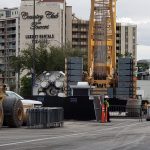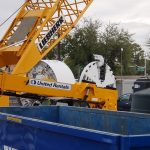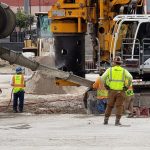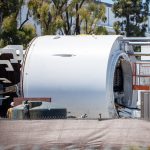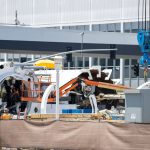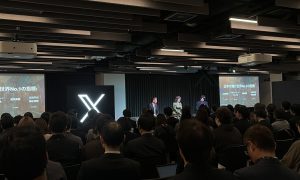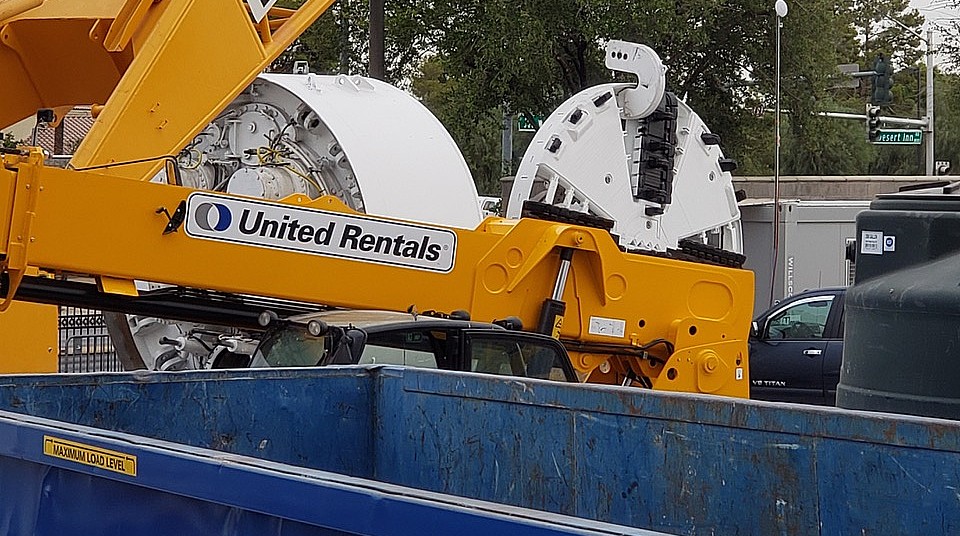

News
The Boring Company’s Las Vegas Loop tunnel project is coming to life
The Boring Company’s upcoming Loop project at the Las Vegas Convention Center appears to be coming to life, with the first images of the startup’s dig site emerging online. Images that have emerged of the startup’s activities reveal that The Boring Company has started shipping parts of a tunnel boring machine to Las Vegas, with a TBM cutter head and mixing chamber recently arriving at the location.
Initial pictures of The Boring Company’s activities were shared on Twitter last week, courtesy of @JamesInLasVegas. The photos depicted heavy machinery surrounding the tunneling startup’s dig site, including several cranes and what appeared to be a pile driver. An image of a tunnel boring machine’s cutter head was also posted.
Elon Musk's tunnel project at the Las Vegas Convention Center just went from WTF to OMFG. (via @JamesInLasVegas) @elonmusk @boringcompany pic.twitter.com/qTqgDZN8J3
— Vital Vegas (@VitalVegas) September 18, 2019
A source familiar with the Boring Company’s current activities for the Las Vegas Convention Center Loop project recently informed Teslarati that the startup’s activities have started ramping over the past few weeks. The source, who has asked to remain anonymous, added that The Boring Company has been granted a pit permit, and thus, the startup has started the construction of a secant wall for the Loop system’s passenger station located on the east end of the LVCC’s South Hall.
Similar to the initial Twitter posts that emerged of the ongoing project, the source also mentioned that parts of a tunnel boring machine started arriving Thursday night. First was what appeared to be a brand new cutter head, followed by a mixing chamber. Both these TBM parts were dropped off at a location that was visible from Desert Inn Blvd.
The Boring Company’s tunnel boring machine segments arrive at the Las Vegas site.
Interestingly, the secant wall is reportedly progressing quickly, and once this is done, excavation will soon follow. Overall, the Las Vegas Convention Center Loop appears to be progressing well, though hitting Elon Musk’s goal of completing the Loop system by the end of 2019 will likely remain a challenging task. But if the company’s digging technology is up for the challenge, the Tesla and SpaceX CEO’s timetable will likely prove feasible.
Much of the details about The Boring Company’s tunneling plans for the Las Vegas Loop system are yet to be announced. Perhaps the biggest question right now is if the startup will be deploying its next-generation TBM for the project. The Boring Company’s Hawthorne test tunnel was built using Godot, a conventional tunnel boring machine. Elon Musk has since announced that the startup is working on two new machines, a hybrid TBM named Line-Storm, which is capable of digging around twice as fast as Godot, and Prufrock, an all-electric TBM that can dig around 10-15 times faster than a conventional tunneling machine, with very little noise and zero emissions.
- The Boring Company works on a tunnel boring machine. (Credit: Teslarati)
- The Boring Company works on a tunnel boring machine.
- The Boring Company works on a tunnel boring machine.
The Boring Company works on a tunnel boring machine.
Images of what appeared to be a new TBM being assembled at the tunneling startup’s lot in the vicinity of the SpaceX headquarters in Hawthorne have been captured a few months ago. With this in mind, there seems to be a good chance that The Boring Company’s Las Vegas project could utilize one of the startup’s newer machines. Perhaps The Boring Company will play it safe and deploy Godot, which has already been tried and tested at Hawthorne, or perhaps the startup could utilize Line-Storm or Prufrock to complete the project faster.
News
Tesla begins Robotaxi certification push in Arizona: report
Tesla seems serious about expanding its Robotaxi service to several states in the coming months.

Tesla has initiated discussions with Arizona transportation regulators to certify its driverless Robotaxi service in the state, as per a recent report from Bloomberg News. The move follows Tesla’s launch of its Robotaxi pilot program in Austin, Texas, as well as CEO Elon Musk’s recent comments about the service’s expansion in the Bay Area.
The Arizona Department of Transportation confirmed to Bloomberg that Tesla has reached out to begin the certification process for autonomous ride-sharing operations in the state. While details remain limited, the outreach suggests that Tesla is serious about expanding its driverless Robotaxi service to several territories in the coming months.
The Arizona development comes as Tesla prepares to expand its service area in Austin this weekend, as per CEO Elon Musk in a post on X. Musk also stated that Tesla is targeting the San Francisco Bay Area as its next major market, with a potential launch “in a month or two,” pending regulatory approvals.
Tesla first launched its autonomous ride-hailing program on June 22 in Austin with a small fleet of Model Y vehicles, accompanied by a Tesla employee in the passenger seat to monitor safety. While still classified as a test, Musk has said the program will expand to about 1,000 vehicles in the coming months. Tesla will later upgrade its Robotaxi fleet with the Cyercab, a two-seater that is designed without a steering wheel.
Sightings of Cybercab castings around the Giga Texas complex suggests that Tesla may be ramping the initial trial production of the self-driving two-seater. Tesla, for its part, has noted in the past that volume production of the Cybercab is expected to start sometime next year.
In California, Tesla has already applied for a transportation charter-party carrier permit from the state’s Public Utilities Commission. The company is reportedly taking a phased approach to operating in California, with the Robotaxi service starting with pre-arranged rides for employees in vehicles with safety drivers.
News
Tesla sets November 6 date for 2025 Annual Shareholder Meeting
The automaker announced the date on Thursday in a Form 8-K.

Tesla has scheduled its 2025 annual shareholder meeting for November 6, addressing investor concerns that the company was nearing a legal deadline to hold the event.
The automaker announced the date on Thursday in a Form 8-K submitted to the United States Securities and Exchange Commission (SEC). The company also listed a new proposal submission deadline of July 31 for items to be included in the proxy statement.
Tesla’s announcement followed calls from a group of 27 shareholders, including the leaders of large public pension funds, which urged Tesla’s board to formally set the meeting date, as noted in a report from The Wall Street Journal.
The group noted that under Texas law, where Tesla is now incorporated, companies must hold annual meetings within 13 months of the last one if requested by shareholders. Tesla’s previous annual shareholder meeting was held on June 13, 2024, which placed the July 13 deadline in focus.
Tesla originally stated in its 2024 annual report that it would file its proxy statement by the end of April. However, an amended filing on April 30 indicated that the Board of Directors had not yet finalized a meeting date, at least at the time.
The April filing also confirmed that Tesla’s board had formed a special committee to evaluate certain matters related to CEO Elon Musk’s compensation plan. Musk’s CEO performance award remains at the center of a lengthy legal dispute in Delaware, Tesla’s former state of incorporation.
Due to the aftermath of Musk’s legal dispute about his compensation plan in Delaware, he has not been paid for his work at Tesla for several years. Musk, for his part, has noted that he is more concerned about his voting stake in Tesla than his actual salary.
At last year’s annual meeting, TSLA shareholders voted to reapprove Elon Musk’s compensation plan and ratified Tesla’s decision to relocate its legal domicile from Delaware to Texas.
Elon Musk
Grok coming to Tesla vehicles next week “at the latest:” Elon Musk
Grok’s rollout to Tesla vehicles is expected to begin next week at the latest.

Elon Musk announced on Thursday that Grok, the large language model developed by his startup xAI, will soon be available in Tesla vehicles. Grok’s rollout to Tesla vehicles is expected to begin next week at the latest, further deepening the ties between the two Elon Musk-led companies.
Tesla–xAI synergy
Musk confirmed the news on X shortly after livestreaming the release of Grok 4, xAI’s latest large language model. “Grok is coming to Tesla vehicles very soon. Next week at the latest,” Musk wrote in a post on social media platform X.
During the livestream, Musk and several members of the xAI team highlighted several upgrades to Grok 4’s voice capabilities and performance metrics, positioning the LLM as competitive with top-tier models from OpenAI and Google.
The in-vehicle integration of Grok marks a new chapter in Tesla’s AI development. While Tesla has long relied on in-house systems for autonomous driving and energy optimization, Grok’s integration would introduce conversational AI directly into its vehicles’ user experience. This integration could potentially improve customer interaction inside Tesla vehicles.
xAI and Tesla’s collaborative footprint
Grok’s upcoming rollout to Tesla vehicles adds to a growing business relationship between Tesla and xAI. Earlier this year, Tesla disclosed that it generated $198.3 million in revenue from commercial, consulting, and support agreements with xAI, as noted in a report from Bloomberg News. A large portion of that amount, however, came from the sale of Megapack energy storage systems to the artificial intelligence startup.
In July 2023, Musk polled X users about whether Tesla should invest $5 billion in xAI. While no formal investment has been made so far, 68% of poll participants voted yes, and Musk has since stated that the idea would be discussed with Tesla’s board.
-

 Elon Musk1 week ago
Elon Musk1 week agoTesla investors will be shocked by Jim Cramer’s latest assessment
-

 Elon Musk3 days ago
Elon Musk3 days agoElon Musk confirms Grok 4 launch on July 9 with livestream event
-

 Elon Musk14 hours ago
Elon Musk14 hours agoxAI launches Grok 4 with new $300/month SuperGrok Heavy subscription
-

 News7 days ago
News7 days agoTesla Model 3 ranks as the safest new car in Europe for 2025, per Euro NCAP tests
-

 Elon Musk2 weeks ago
Elon Musk2 weeks agoA Tesla just delivered itself to a customer autonomously, Elon Musk confirms
-

 Elon Musk1 week ago
Elon Musk1 week agoxAI’s Memphis data center receives air permit despite community criticism
-
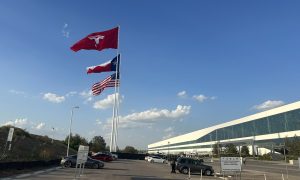
 Elon Musk2 weeks ago
Elon Musk2 weeks agoTesla’s Omead Afshar, known as Elon Musk’s right-hand man, leaves company: reports
-

 News2 weeks ago
News2 weeks agoXiaomi CEO congratulates Tesla on first FSD delivery: “We have to continue learning!”

